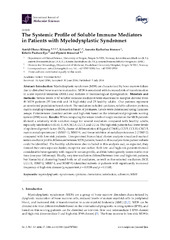| dc.description.abstract | Introduction: Myelodysplastic syndromes (MDS) are characterized by bone marrow failure due to disturbed bone marrow maturation. MDS is associated with increased risk of transformation to acute myeloid leukemia (AML) and features of immunological dysregulation. Materials and methods: Serum levels of 47 soluble immune mediators were examined in samples derived from 49 MDS patients (35 low-risk and 14 high-risk) and 23 healthy adults. Our patients represent an unselected population-based cohort. The mediators included cytokines, soluble adhesion proteins, matrix metalloproteases, and tissue inhibitors of proteases. Levels were determined using Luminex assays. Patients were classified as low- and high-risk based on the international prognostic scoring system (IPSS) score. Results: When comparing the serum levels of single mediators the MDS patients showed a relatively wide variation range for several mediators compared with healthy adults, especially interleukin 6 (IL-6), IL-8/CXCL8, CCL3, and CCL4. The high-risk patients had lower levels of epidermal growth factor (EGF), cluster of differentiation 40 ligand (CD40L), CCL5, CCL11, CXCL5, matrix metalloproteinase 1 (MMP-1), MMP-9, and tissue inhibitor of metalloproteinases 2 (TIMP-2) compared with low-risk patients. Unsupervised hierarchical cluster analysis visualized marked serum mediator profile differences between MDS patients; based on this analysis three patient subsets could be identified. The healthy adults were also included in this analysis and, as expected, they formed their own separate cluster, except for one outlier. Both low- and high-risk patients showed considerable heterogeneity with regard to serum profile, and this heterogeneity seems stable over time (one year follow-up). Finally, very few mediators differed between low- and high-risk patients, but hierarchical clustering based both on all mediators, as well as five selected mediators (EGF, CCL11, TIMP-2, MMP-1, and MMP-9) identified subsets of patients with significantly increased frequency of high-risk disease (χ-square test p = 0.0158 and p = 0.0148). | en_US |

